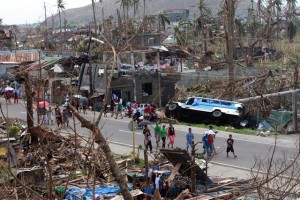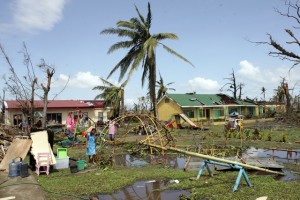Typhoon Haiyan diary 1: “There is nowhere to go”
2013-11-11
In the Philippines, the devastation of a 'super typhoon' has left communities helpless, while the Government and relief groups struggle to mount aid operations.
By Christopher de Bono, Regional Chief of Communication, UNICEF East Asia and Pacific


|
MANILA, Philippines/ HONG KONG, 11 November 2013 – I just got off the phone with Nonoy, a UNICEF colleague in Tacloban City, in the Philippine province of Leyte. He is a thorough professional, an old hand who has seen disasters and devastation before. But there was a quiver in his voice. “People, families with children are walking along the ruined roads,” he said. “I don’t know where they are going – there is nowhere to go. They are walking because their homes are gone and they have nowhere to go.” Many have nothing It had taken him an hour to get out of the airport because of the deis on the road. Some other colleagues had been stuck in the airport overnight. The roads are almost impassible in the pitch black night, and the risk of accidents is very real – not only to drivers and passengers, but also to people camping on the streets. “So many people have nothing. Their children are hungry, some are sick, and they are frustrated,” Nonoy explained. Who wouldn’t be? I can only imagine what it feels like to be utterly unable to comfort or even feed my daughter. We’ve been through some tough times, but I have always been able to give her food and shelter, and help her when she’s ill. At the moment, these people can’t do that, and there’s nowhere for them to turn for help. There have been local media reports of looting, but Nonoy described people desperate for food for their hungry families “salvaging” rice from a damaged and deserted warehouse. |
Reinforcements from the Philippines army are helping local police restore order in Tacloban. But the things people need most just aren’t there. Many of the authorities –local civil servants – have also lost loved ones and homes.
Logistical challenge
What children in Tacloban City need right now is food, shelter, clean water and basic medicines.
There is hope for them. The airport is now functioning, and transport aircraft are inging in urgent aid and supplies. Local authorities are reestablishing the order necessary to distribute aid and meet people’s needs – slowly and with great difficulty, but with support from UNICEF and our partners.

|
Logistics are a huge challenge – getting aid and expertise to the right places; finding the petrol to move them; setting up systems for distribution, and reestablishing communications links. There are many parts of the country that were in the path of Typhoon Haiyan that are still inaccessible, so there is a lot we still don’t know, and many children – probably millions – who desperately need our help and are not yet receiving it. Two other population centres of particular concern are northern Palawan and Ormac in Leyte, where we are yet to know what suffering has occurred or how many children need our help. Tomorrow we will know more from our colleagues who have just arrived in Ormac. Fingers crossed. |
Donate NOW to help the children of the Philippines |









